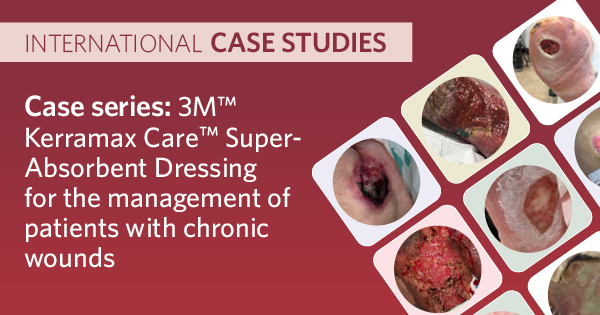EXUDATE MANAGEMENT AND THE ROLE OF 3M™ KERRAMAX CARE™ SUPER-ABSORBENT DRESSING
Management of exudate is one of the biggest challenges in wound care. Highly exuding wounds can have a significant negative impact on quality of life as a result of (Browning, 2016; Hughes and Jones, 2017; World Union of Wound Healing Societies, 2019):
- Saturation or loss of adhesion/integrity necessitating unscheduled dressing changes
- Strikethrough increasing the risk of infection, as exudate contains bacteria
- Periwound skin becoming macerated and painful
- Patients experiencing limited mobility or be unable to perform normal activities of daily living (such as work, shopping and cooking)
- Social interaction being curtailed or avoided due to leakage or malodour
- Patients feeling a burden on carers and family members, who must change dressings at short notice.
It is important to select the most appropriate dressing based on safety, comfort and efficacy. Strikethrough occurs when the dressing used is not suitable for the volume of exudate or planned wear time (Browning, 2016).
Kerramax Care Dressing is a super-absorbent polymer dressing range [Box 2], indicated for the control and removal of excess exudate in moderate to highly exudating wounds. These dressings have a greater absorption capacity than traditional foam dressings. The super-absorbent core with Exu-Safe™ Technology absorbs and retains high levels of exudate, which may contain potentially harmful bacteria and matrix metalloproteinases * , helping to keep it within the dressing core to reduce the risk of skin maceration and to protect patients and caregivers from its harmful contents (Hughes and Jones, 2017; Singh et al, 2022). The super-absorbent polyacrylate polymers form a gel on contact with exudate, locking away fluid, bacteria, proteases and inflammatory mediators, all while providing a moist healing environment (Hughes and Jones, 2017; Singh et al, 2022). The gelling action decreases the risk of leakage and maceration, and increases dressing wear time, improving patient quality of life, as dressing changes are often painful and traumatic (Hughes and Jones, 2017). Kerramax Care Dressing has demonstrated good fluid absorbency and retention over periods of up to 3 to 7 days (Singh et al, 2022).
These dressings can also be used in conjunction with compression if oedema is present. Kerramax Care Dressing has a thin profile and evenly distributes exudate under compression through lateral wicking, resulting in fewer leaks (Jones and Barraud, 2014). When paired with the 3M™ Coban™ 2 Two-Layer Compression System, Kerramax Care Dressing effectively manages exudate, remains in its position over time, whilst the Coban 2 Layer Compression System is a two-layer compression bandage system that is designed to deliver therapeutic compression to address oedema (Hughes et al, 2022).
BENEFITS IN CLINICAL PRACTICE
An evaluation of the safety, effectiveness and patient experience of Kerramax Care Dressing involving 101 patients with moderate to heavily exuding wounds of various aetiologies found the dressings had the ability to control exudate and strikethrough and prevent damage to the periwound skin (Hughes and Jones, 2017).
In another study, a nursing evaluation involving 54 patients highlighted the main clinical benefits of Kerramax Care Dressing as being exudate management, reduced maceration and reduced dressing changes (Jones and Barraud, 2014).
Published case studies have also reported that Kerramax Care Dressing is effective for fluid handling and can be used in conjunction with compression. Furthermore, a series of eight venous leg ulcer cases evaluating Kerramax Care Dressing plus Coban 2 Compression System found the combination to be acceptable to patients, as well as effective and comfortable to wear (Hughes et al, 2022).
KERRAMAX CARE DRESSING CASE SERIES
Many of the chronic wounds in this case series have occurred in older patients with underlying conditions that can cause wounds to develop (e.g. diabetes or venous insufficiency) or impair healing (e.g. infection or malnutrition). The wounds have produced moderate to very high volumes of exudate that previous dressings had not been able to handle. Additionally, the patients in this case series had conditions that indirectly complicated their wound management.
Ulceration is a serious complication of lymphoedema that makes it difficult to use compression and results in high volumes of drainage. The need for regular dressing changes limits patients’ independence, imposing a burden on nursing staff and caregivers. Two case studies (Milne, pages 6—7 and Snyder, pages 10—11) highlight this challenge, with foam dressings and abdominal pads being unable to effectively manage the quantities of fluid exuding from the wounds. Kerramax Care Dressings, by contrast, rapidly reduced the number of dressing changes by absorbing fluid and locking it away from the wound bed. This not only supported a moist healing environment but also enabled sustained use of compression to address oedema.
In cases where patients had limited mobility, the selected dressings needed to withstand lifting and handling pressures. In patients with leg ulcers, the dressing had to remain in place and intact during activities of daily living, such as walking or resting the leg on a supporting surface. Kerramax Care Dressing demonstrated an excellent ability to withstand shear forces while adhering to difficult-to-dress areas such as the sacrum and calf.
When compared to previous treatments, patients able to communicate clearly reported reduced pain during Kerramax Care Dressing changes. They said the dressings were comfortable to wear. Patients and nursing staff were pleased with the improved exudate management and decreased number of dressing changes.
CONCLUSION
A wide range of factors need to be considered when selecting the most appropriate wound dressing for individuals with highly exuding wounds. This case series demonstrates that Kerramax Care Dressings are effective at handling large volumes of exudate, remaining in place and intact during patient movement and when saturated with exudate or lymph fluid. The improved dressing wear time enhanced patients’ quality of life while reducing bioburden and addressing complications, such as maceration.





